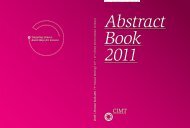Abstract Book 2010 - CIMT Annual Meeting
Abstract Book 2010 - CIMT Annual Meeting
Abstract Book 2010 - CIMT Annual Meeting
Create successful ePaper yourself
Turn your PDF publications into a flip-book with our unique Google optimized e-Paper software.
115 Lladser | Enhancing immunity & adjuvants<br />
DAI (ZBP1/DLM-1) as a novel genetic adjuvant for cancer DNA<br />
vaccines that promotes CTL responses, overcomes tolerance and<br />
confers long-term tumor protection.<br />
Alvaro Lladser 1 , Dimitrios Mougiakakos 1 , Helena Tufvesson 1 , Andrew F.G. Quest 2 , Karl<br />
Ljungberg 1 *, Rolf Kiessling 1 *<br />
1 Immune and Gene Therapy Laboratory, Cancer Center Karolinska, Department of Oncology and Pathology,<br />
Karolinska Institutet. Karolinska Hospital R8:01, SE-17176 Stockholm, Sweden<br />
2 Laboratory of Cellular Communication, FONDAP Center for Molecular Studies of the Cell, Program of Cellular<br />
and Molecular Biology, Facultad de Medicina, Universidad de Chile, Santiago, Chile<br />
* KL and RK contributed equally to this work<br />
DNA vaccination is an attractive approach to induce<br />
antigen-specific cytotoxic T cell (CTL) responses<br />
capable of providing long-lasting protective immunity<br />
against cancer. Although effective in animal<br />
models, DNA vaccines against cancer have shown<br />
limited efficacy in clinical trials. Therefore, efficient<br />
delivery systems and powerful adjuvants are<br />
needed for DNA vaccines to overcome tumor-associated<br />
T cell tolerance. Indeed, the early activation<br />
of innate immune receptors and downstream signaling<br />
pathways are essential to promote effective<br />
adaptive immunity. Consequently, DNA vaccines<br />
benefit from adjuvants that boost innate immunity<br />
signaling. We have used the recently described cytosolic<br />
DNA sensor Z-DNA binding protein 1 (ZBP1<br />
also known as DLM-1), termed DNA-dependent activator<br />
of interferon regulatory factors (DAI) as a<br />
genetic adjuvant for DNA vaccines. In vivo electroporation<br />
(EP) of mice with a DAI-encoding plasmid<br />
(pDAI) promoted transcription of genes encoding<br />
type I interferons (IFNs), proinflammatory cytokines,<br />
chemokines and co-stimulatory molecules.<br />
Co-immunization of pDAI and antigen-encoding<br />
plasmids enhanced both in vivo antigen-specific<br />
proliferation and induction of CTLs. Moreover, codelivered<br />
pDAI overcame CTL-tolerance to a tumorassociated<br />
antigen (TAA) and conferred long-term<br />
anti-tumor protection. The DAI-adjuvanted CTL induction<br />
required NF-κB activation and intact type I<br />
IFN signaling, but not interferon regulatory factor<br />
(IRF) 3. This study demonstrates the potential of<br />
using intracellular innate sensors as genetic adju-<br />
vants to improve DNA vaccine potency.<br />
Acknowledgements: Research described here has<br />
been supported by grants to RK from the Swedish<br />
Cancer Society, the Swedish Medical Research<br />
Council, the Cancer Society of Stockholm, the European<br />
Union (Grant “EUCAAD” and “DC-THERA”),<br />
the Karolinska Institutet, “ALFProject” grants<br />
from the Stockholm City Council. AFGQ has received<br />
support from ICGEB (International Center of<br />
Genetic Engineering and Biotechnology, Trieste,<br />
Italy) grant CRP/CH102-01, Wellcome Trust award<br />
WT06491I/Z/01/Z and FONDAP grant 15010006.<br />
AL has been supported by a Fellowship for Postgraduate<br />
Studies “Presidente de la República” from<br />
CONICYT, Chile. DM was supported by a grant of<br />
the German Research Association (DFG). KL has<br />
been supported by a postdoctoral fellowship from<br />
the Swedish Society for Medical Research.<br />
165



